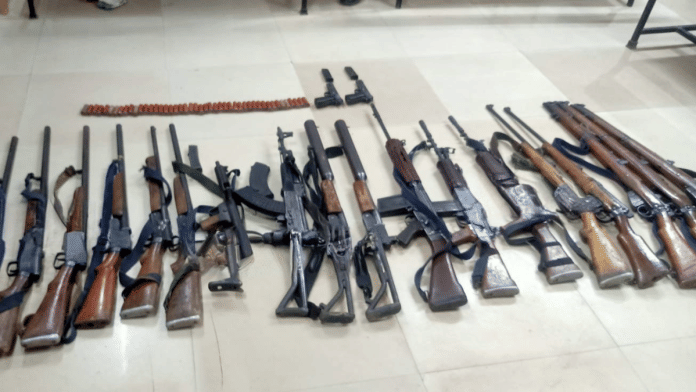New Delhi: Backed by intelligence from the ground and from the home ministry, 200 personnel from the District Reserve Guard of the Chhattisgarh Police and the Border Security Force (BSF) managed to enter the Maoists’ den — the Abujmarh forests in Bastar — for the first time Tuesday.
The operation, which had been planned for several days, led the security forces to a Naxalite meeting in the hilly terrain and an encounter that resulted in the deaths of 29 suspected Maoists. It also led to the recovery of 22 weapons, including AK-47s and even INSAS rifles snatched from police personnel earlier, as well as SLRs, carbines and pistols.
The encounter began around 1:30 pm and lasted for over five hours, even as the overall operation went on late into the night. Only three security personnel were injured in this encounter, which came three days before Bastar goes to the polls.
Among those killed were two suspected Maoist divisional committee members — Shankar Rao, who had a reward of Rs 25 lakh against his name, and Lalita, who carried a reward of Rs 9 lakh. Another suspected Maoist, Vinod Gawde, who had a reward of Rs 10 lakh against his name, was also killed.
For the forces, this encounter comes as a major achievement because this is the first time that they have been able to breach Abujmarh, sources in the security establishment told ThePrint.
The development came days after 11 Maoists — including a “company commander” — were killed in another major counterinsurgency operation that involved over 800 security personnel in Chhattisgarh’s Bijapur district.
Also Read: Propaganda or political? Bastar: The Naxal Story teaser sparks what Sudipto Sen intended
Thick forests, no posts & a tricky landscape
Explaining how the encounter ensued, the sources said that over the past few months, the security forces had established posts in the fringe areas, including areas of Narayanpur and Kanker.
“However, despite efforts, we couldn’t get inside this area. This operation marks the entry of the security forces in an area that the Naxals considered a ‘safe haven’,” a source who was part of the operation told ThePrint.
The sources said that entering Abujmarh came with its own set of challenges.
While the hilly terrain and the thick jungle made the landscape tricky to breach for security forces, the Maoist cadres’ superior knowledge of the land gave them an upper hand.
“The Abujmarh area had no forward posts,” another source said, adding that it is a hilly and densely forested Naxal area with little to no connectivity and until now, had been out of the forces’ reach.
Sources said they managed to garner “solid intelligence” about Maoist movements in the area. “Elections are scheduled in just three days, so the security forces are keeping a close watch on all areas, especially in this area where there’s constant movement of (Maoist) cadres. On Tuesday, we got inputs of 45-50 Maoists moving around in the area,” a third source said.
Significantly, this is the season for collecting tendu leaves, the trade of which is considered a significant source of income for Maoists.
“We received the input and forces moved to encircle the area. Their guards were on duty; there was a meeting happening. The security forces encircled the entire area and asked them to surrender. There was chaos and the Maoists started firing. Then security personnel retaliated,” the source said.
The sources said that helicopters were kept on stand-by to deal with any eventuality and a backup team was also in place.
Sources said that this particular Naxalite group had also given a call to boycott the Lok Sabha elections in the area and it was suspected that they were been planning something to disrupt the polls.
Decline of LWE incidents
According to data from the security forces, 79 suspected Maoists have been killed in the past three-and-a-half months alone.
This is more than the number killed in the past three years — while 24 were killed in 2023, this figure stood at 30 in 2022, 47 in 2021, and 36 in 2020.
According to the data that the Ministry of Home Affairs shared with the Lok Sabha last August, there was a 76 percent drop in left-wing extremism (LWE)-related violence and a 90 percent decline in casualties — both from security forces and among civilians — between 2010 and 2022.
The number of LWE-affected districts has also come down to 45 in 2022 from 96 in 2010.
In December, the home ministry said that LWE incidents had come down in Chhattisgarh — the state saw 305 such incidents in 2022, down from 392 in 2018.
(Edited by Uttara Ramaswamy)
Also Read: NIA raids put focus on Maoism in UP. How Red tide rose until 2-pronged strategy brought it down






